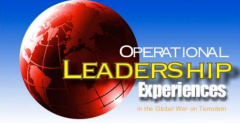It took years, but eventually U.S. troops traveled Iraq roads inside well-protected Mine-Resistant, Ambush-Protected vehicles.
While some folks maintain that armies are always busy fighting the last war, Major Geraldo Pulido argues that the U.S. Army, from his vantage point, did a pretty good job of adapting to changing circumstances during his four combat tours in Iraq.
In this interview last August with the Combat Studies Institute at Fort Leavenworth, Kan., the logistics officer focuses on the issues both big and small that matter to the grunts on the ground. Excerpts:
I remember the first questions going in for the initial invasion being the question about, “What are we going to eat and drink?”
Those were our main concerns, and now the questions being asked are, “Where are we sleeping?” and “Which containerized housing unit am I going to get?” and, “Does it have cable? Does it have internet?”
The questions have changed from the first invasion of, “What am I going to eat and drink?” to now “What internet speed am I going to have?”
One spectrum to the other, I thought it was kind of funny…
The initial invasion was with soft-skinned vehicles with vinyl tarp and that’s all you had. We’d be driving and we’d hear weapons being shot and seeing bullet holes in the back of our vehicle, or driving and seeing mortars falling on the sides of our vehicle, thinking, “That was a close one. We saw lots of that, but that went along with it.
In my second tour it got more aggressive and more lethal. Now they were using rocket-propelled grenades and that’s when we started seeing the first signs of improvised explosive devices.
We still had our soft-skinned vehicles with tarps. That’s when the rush came to modify the vehicles. The first step they did was to look for steel, and they way they would test it was to shoot an AK-47 into the metal, and if it was able to stop it, they would use that type of sheet metal and modify the vehicles to at least cover the drivers.
They used to call it hillbilly armor for vehicles.
All they would do was put four sheets on the sides and top, and there you go. They’d send you out on convoys like that.
After a while, the insurgents started modifying their tactics, techniques and procedures and started using larger ammunition, bigger tonnages and larger types of ammunition that could penetrate what we had done.
Just like we learn and adapt, so does the enemy. They learn and adapt. When you develop a new technology for something, they’re already countering that.
It’s always like that, counter/action, counter/action. We saw lots of that and we see that now. We have the up-armored vehicles, and they’re finding penetrators that can go through our protective armor.
They just increase the lethality of their weapons, and we modify from that and go from there…
I think we’re doing good as an organization, being able to learn as we fight and then change and implement whatever needs to be changed.
If there is a deficiency in equipment, being able to identify what that deficiency is and say, “Look, there’s a gap in the way we fight, let’s invent that system and implement it,” in a quick timeframe. The mine-resistant ambush-protected [vehicles] were identified as needed, and within a year, units were getting them.
That’s a pretty quick turnaround.
I think we’re doing the right things.
I think we’re a learning organization, and I think we can adjust and implement things quick enough to win at the end of the day



